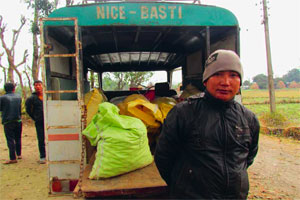Many cultivators in Dhaubadi, in the Nepalese district of Nawalparasi, are benefitting from extension programmes and better communication facilities and are changing their relationship with the market as a result.

The middleman who comes to Dhaubadi to buy their crops offers a very low price. So farmers, such as Gajbir Baraghare, are actively developing an alternative: exchanging their crops for rice produced in other areas in the Terai, the high-yielding lowland plains at the foothills of the Himalayas. This approach is proving to be effective: farmers in the Terai are pleased to exchange their rice for crops that they don’t grow themselves, and are happy to have organic potatoes and other crops delivered to their doors, and “paying” for them with rice.
In February 2013 Mr Baraghare went to Kawasoti with a pick-up truck full of potatoes and ginger. He exchanged all the potatoes for rice and sold the ginger in the local market town, thus also generating the money he needed to meet his family’s essential needs.
Text and photo: Sandesh Timilsina
IAAS, Rampur, Nepal

